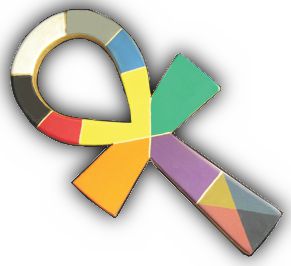 While people bang on endlessly about the elemental tools, and the god-awful lotus wand, one very important Golden Dawn adept tool is never mentioned or made – the Ankh.
While people bang on endlessly about the elemental tools, and the god-awful lotus wand, one very important Golden Dawn adept tool is never mentioned or made – the Ankh.
The Ankh is part of the 5-6 and is carried in the left hand. There is little paperwork about it, and modern Golden Dawners do not consider it part of their magical equipment. But the reality is that of all the tools it is one of the most important and a key part of rituals.
Ankh, was originally an Egyptian hieroglyph used to represent the word “life” or “eternity.” By extension, this cross became primarily a symbol of life. The ankh was associated with the gods who may carry it in their hand or hold it up to the nose of the deceased so they can breath in eternal life. Water poured over the head of the pharaoh as part of a purification ritual, was represented by chains of ankhs and was (representing power and dominion) symbols.
So in the hands of an adept an Ankh is a symbol of their eternal life and immortality and divine status. It is a composite of the three officers of the outer order who represent life (represented by the Greek letter H) with a knock on effect on the Z documents.
Golden Dawn use
In the GD the ankh was painted in the colours of the Tree of Life to emphasise this divine power, and this is, more or less, how the tool is seen by modern magicians. You could get away with making a pendent or wearing a teeshirt and do not need to make another tool.
However, the Ankh is a lot more than a symbol and as a tool it has more uses. When grasped through the loop and pointed at an object it projects divine power and life. New Zealand Golden Dawn Adept Jack Taylor used this as his party trick and the effect was like being punched in the guts. It becomes useful in rituals where such enlivening is needed, such as creation of artificial daemons, talismans or alchemical procedures. In such cases, it is like the Golden Dawn’s DWB formula bringing divine and eternal light to the object.
Another meaning for the Ankh is as a “complete person” While living, the Ankh was composed of all five elements – body, Ba (personality), Ka (soul), Name, and Shadow. When dead or when you are asleep the Ankh was the reunion of the Ba and the Ka. Ancient Egyptian tombs refer to “angry Ankhs” who were the spirits of the dead which could harm and curse the living. This provides another use of the tool which is to scare humans and other spirits (which might be one of the reasons why the Golden Dawn applied the Ankh to the headless ritual).
So, this provides another important meaning for the tool. It is held in the left hand (the one closest to the heart). As an adept, you are effectively holding your own self and projecting divine power through it to achieve your goals. By using it, you are saying “the intention of this ritual is coming through me.” There might be some rituals where you do not want to make this statement, but they would be rare as most rituals are earthed through the personality.
A magician may hold a GD Ankh by one of the coloured slices to project Sephirotic power into an object through Malkuth. If you wanted to project Geborah you would hold the cross by the red part (ironically like a toy gun). Some care needs to be taken here because you will be unbalancing the personality to obtain the magical effect you want. Indeed this is the danger of using this tool, in that all power it uses come through some aspect of the personality. Following Egyptian practice, if you want to enliven something you would touch it with the loop part of the cross but if you want to create a material result you would hold it by the loop.
You would not use the Ankh to draw a symbol in the air (like a pentagram)… it is the symbol and brings life and healing.

Comments are closed